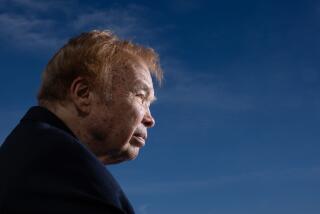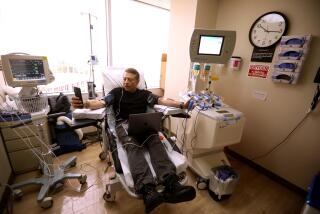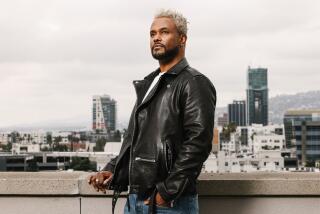COLUMN ONE : The Perils, Pleasures of Fame : In 1967, heart transplant pioneer Christiaan Barnard gained instant celebrity. Since then, he’s enjoyed the high life, but also has endured personal scandal and professional controversy.
- Share via
CAPE TOWN, South Africa — It all began with twin tragedies. A horrible traffic accident had left 25-year-old Denise Darvall brain-dead, though her heart was beating. Louis Washkansky, suffering from heart disease, was hours, perhaps minutes, from death.
On that day 26 years ago, a gutsy South African surgeon transplanted Darvall’s heart into Washkansky’s body.
Washkansky lived only 18 days, but the feat made Dr. Christiaan Barnard, at age 45, an instant worldwide celebrity. Now this pioneering surgeon is 71, and the story of his years in the relentless limelight is itself a kind of modern tragedy.
“At one stage, I had the whole bloody world at my feet,” Barnard recalled recently, sipping tea in his living room. “I was a famous guy. But I always realized it wouldn’t last forever.”
In the beginning, back in 1967, there were television appearances, honorary degrees, an audience with the Pope and long chats with presidents, princes and kings. There were beautiful film stars, illicit affairs, yachts, champagne and more forbidden fruit than this son of a church missionary, reared in South Africa’s raw Karoo Desert, could resist.
Much of it made headlines here, and, soon, Barnard and his first wife divorced.
Over the ensuing years he fought with hospital administrators, apartheid authorities, jealous doctors, hostile journalists and even, most recently, the organizers of South Africa’s “Best-Dressed Woman” contest. He endured a son’s suicide, which he blamed on his own inattention. A second marriage, to a much younger woman, failed. And he developed a near-obsession with aging.
The fame “was a habit-forming type of thing. I regret that I ran after that so much,” Barnard said. “My (heart transplant) unit suffered so much. We had all the facilities and ingredients to be great. But I was away too much. And I often wonder what I could have achieved.”
Barnard still is one of South Africa’s most famous, outspoken and controversial sons. Retired from surgery for a decade, he lives here with his third wife, Karin, 29, and their 4-year-old son on a 30,000-acre farm at the edge of the Karoo, a four-hour drive away.
He deflects questions about his wealth, though he says his main income is his government pension of about $15,000 a year, supplemented with consulting fees and proceeds from his books.
He has just finished his 13th book, “The Second Life,” a surprisingly frank memoir of the aftermath of his first transplant. The book, sometimes sentimental and often bitter, recounts in equally vivid detail his surgical procedures, sexual conquests and fondness for the spotlight.
Barnard’s name still makes headlines in his homeland, usually to his chagrin.
A few weeks ago, he created a stir when the Greek government approved his 15-year-old application for citizenship. The prospect of Barnard leaving now, just as blacks are on the verge of taking power, was widely criticized.
Why Greece? Barnard said he has always been intrigued by the birthplace of Hippocrates, the father of medicine, and once looked into starting a clinic on the island where Hippocrates was born.
Beyond that, he added, “I like the people and the food.”
Barnard said he does not intend to leave South Africa for good just yet.
But the new passport gives him more freedom to travel in Europe and, he acknowledged, an escape hatch should things turn ugly at home.
“I still think South Africa is a fantastic country, but I see on TV every night that all these people are being killed,” he said. “I don’t want my child to grow up in that environment.”
Today, Barnard still travels the world, giving lectures to smaller audiences, participating in some heart research and exploring business opportunities in Greece.
His passion these days is research on ways to stop or slow the aging process.
Aging is a “disease,” as he calls it, that afflicts him.
He feels, to put it bluntly, old.
Although Barnard has had painful arthritis for the last 35 years, he appears extremely healthy as he sits for an interview in a turtleneck, corduroys and running shoes. His hair is thinning. But he remains an imposing figure, tall and slender with his wide, toothy smile.
“Aging is the commonest disease in the world,” Barnard said, warming to the topic. “Unfortunately, I know how my own quality of life has deteriorated. I remember days when I could work the whole night and the next day, and then go out that night.”
Being married to Karin, who was just a youngster when the first transplant was performed, seems only to highlight his feelings about age.
“At a party these days, I’m tired by 3 a.m, especially after a few drinks,” he said. “But Karin is still going strong.
“My metabolism has changed,” he added. “That was the main reason I retired (from surgery). You must be hungry for it, but I had lost that. Some mornings, I thought about saying I was too sick to do surgery.”
After retiring in 1983, Barnard worked for four years as “scientist in residence” at Baptist Medical Center in Oklahoma City, earning enough to buy his farm.
He was also associated with a Swiss medical institute studying ways to halt aging; his controversial endorsement of an anti-aging skin cream prompted the American College of Surgeons to consider disciplining him.
Barnard resigned from the group in a huff rather than fight the disciplinary action.
(The doctor contends that he was a victim of unscrupulous business people and that he had never agreed to endorse the product.)
Barnard’s odyssey began the day of the first transplant. Before that, he had been just a promising government surgeon. He had studied surgery for two years in Minneapolis and returned to start the first cardiac surgery unit at Groote Schuur Hospital in Cape Town.
Being the first to do a heart transplant operation, though, was “just luck,” he said. “It was not a scientific breakthrough, just a technical one.
“There were many surgeons in the United States at the time who could have done it,” Barnard added. “But it was as if all of us were standing around the swimming pool, asking each other, ‘Is the water cold?’ Any of us could have jumped in. But when I did, everyone followed.”
Barnard expected and, in fact, welcomed critical attention from colleagues.
“Many in the medical profession will say their first concern is for the patient,” he writes in his book. “But a doctor, like anyone else, wants above all to satisfy his own ambition and ego.”
Most cardiac surgeons agree: If Barnard had not done it, someone else would have. But, when it happened, and when the patient lived, it touched off a flurry of transplants worldwide.
“It took an enormous amount of courage,” said Dr. Hillel Laks, chief of cardio-thoracic surgery at UCLA Medical Center and director of its heart and heart-lung transplant program. “The fact that there may have been a handful of other people in the world who had an equal amount of courage, and would have done it anyway, does not detract from the fact that he was the first.”
The procedure has come a long way since then, thanks largely to new drugs that are better able to overcome the body’s tendency to reject donor organs. The UCLA unit, the second-biggest in the United States, performed 75 heart transplants last year. This year, it will probably do 80. And the average heart transplant patient today has an 87% chance of being alive a year after surgery.
Although Laks was born in South Africa, he moved to the United States for his training and never worked with Barnard. But, like many heart surgeons today, he admires Barnard’s work in pediatric heart surgery as well as transplants.
“He’s a very brilliant man, incisive and analytical,” Laks said. “And he also has a very charismatic personality. If he had had less charisma, the heart transplant might have gotten less attention.”
What Barnard did not anticipate, though, was the intensity of the world’s attention.
“The transplant kicked up so much dust,” he recalled. “We were not set to handle that.”
And yet he has spent most of the last quarter of a century alternately enjoying the attention and complaining about it.
A few days after Washkansky received his new heart, Barnard was taking his first sips of French champagne in the first-class cabin of an airplane. He and his then-wife, Louwtjie, were flying to the United States for a television interview--a decade before South Africa first got television.
His memories of that flight? The American attendants (“They smelled clean and they shaved their legs,” he writes) and his wife’s dourness. “How long do you think this charade will last?” he remembers her asking. He did not answer but says he thought: “If this is life in the fast lane, I want to enjoy every last second.”
Although Barnard blames the media for breaking apart his first marriage, he admitted that it was on rocky ground even before the transplant. He writes of affairs during his time in Minneapolis and revels in more affairs after the transplant with, among others, Gina Lollobrigida and an unidentified former Miss Italy.
“With great difficulty I shrugged off the guilt because, what the hell, I was enjoying myself,” he writes.
Barnard’s marriage essentially ended in a San Francisco hotel room, on the 23rd floor, when his wife discovered a love letter from Lollobrigida in his luggage. Louwtjie threatened to commit suicide, and Barnard went downstairs to address the American College of Cardiology, not knowing if she would carry out her threat.
When he returned, she had calmed down. But their 18-year marriage, which produced a son and daughter, was over.
And Barnard had no regrets.
“It was an unbelievable experience for a barefoot Karoo boy--suddenly able to get virtually any girl he wanted,” he said.
And he was sure it was not just his fame: “Women enjoyed being in bed with me.
“I have few regrets--and mostly I only regret the things I haven’t done.”
In between travels abroad, Barnard participated in 165 heart transplants.
“For the first few years, I did most myself,” he said. “At the end, though, I didn’t even lift a scalpel.”
He does not remember most of his patients and, unless some journalist brings one around to take a photograph, he doesn’t keep in touch with them.
“I can’t remember thousands of my operations,” he said. “After the second or third, I can’t even remember the transplants.”
One case that does stick in his mind, though, is that of Dirk van Zyl, a 47-year-old white government clerk whose doctor had given him weeks to live.
Barnard accepted Van Zyl as his sixth transplant patient in 1971; a week later, the heart of Damon Meyer, a 35-year-old farm worker, became available.
(Meyer, in the argot of apartheid, was Colored, or of mixed race. Barnard had avoided using a nonwhite donor for the first transplant for fear that, if it failed, he would be accused of experimenting on blacks, a sensitive topic in a country where the voteless black majority was ruled by a white minority.)
Van Zyl’s case turned out to be the doctor’s worst nightmare. As the patient lay on the operating table and doctors prepared to administer the anesthetic, Van Zyl’s own heart stopped beating. Without restarting the heart, doctors did not have time to open the patient’s chest, put him on a heart-lung machine and do the transplant.
The doctors battled for half an hour to restart his heart, using defibrillation and massage. They were about to give up when one last surge of electric current restarted it, allowing the transplant to proceed.
Today, Van Zyl is 67, the longest surviving heart transplant patient in the world. He lives with his wife of 35 years, Beatrice, in a modest, beige home in a suburb of Cape Town.
“I became a healthy man again,” Van Zyl said in an interview. “The same as before.”
For 15 years after the operation, Van Zyl made the daily one-mile commute to work on a bicycle. And he has never had to see a doctor again about his heart.
Diabetes, which could be a result of the transplant, forced him to retire seven years ago, and he lost both legs to the disease.
Though now in a wheelchair, Van Zyl gardens and spends long hours with his two grown sons and his 18-month-old grandson.
“I’ve lived a full and happy life,” Van Zyl said. “I wouldn’t say I owe my life to Dr. Barnard, though. That comes from another place. He did the good work, but he gets his knowledge from God.”
After the first few transplants, Barnard continued to do other experimental surgery.
He performed the world’s first double-heart transplant in 1970, leaving the patient’s own heart and adding a donor heart. That patient lived 18 years.
“I saw in the newspapers that he had died,” Barnard said.
But his surgical activity was often interrupted by the attention he was getting outside South Africa.
His suits were made by an Italian tailor; he vacationed with Peter Sellers, among other stars; he accepted awards from dozens of countries; one year, he even judged a Miss Topless contest in Yugoslavia.
The first transplant “remained such an important event in the world that there was no need to do something else,” Barnard said.
Back home, his personal life was, at times, a shambles.
His son, a pediatrician and father of two, became addicted to prescription drugs and was found dead in his own bathtub, a suicide.
“It was probably because of a lack of support from me,” Barnard writes in his book.
Barnard also was under pressure to use his international standing to push for changes in the apartheid system.
Although the surgeon had raging fights with hospital administrators, who wanted him to keep his patients in racially separate wards, he smarted from the ostracism he encountered as a white South African abroad. And he now admits that he probably did not do enough to fight apartheid.
“I only did enough to assuage my conscience,” he said, “but not enough to rock the boat.”
And he said he still believes that the country’s leaders in the 1960s, the architects of apartheid, were “very nice men” who, as one told him, “could only lead as far as the people will follow.”
From the early days of his life in the public eye, Barnard has been a favorite subject for gossips and newspapers in South Africa. Although Cape Town has a population of 1 million, it is a surprisingly intimate place for the relatively small group of white professionals and members of high society.
Two years ago, when Karin Barnard came in second in the contest for South Africa’s “best-dressed woman,” Barnard created a stir by striding over to the organizer’s table and complaining: “Your competition is a farce, and my wife never wants to be part of it again.”
Oddly enough, Karin Barnard had placed third the year before, when the winner was Barbara Silva, to whom Barnard had previously been married. (Their marriage, Barnard’s second, lasted only a few years; they had no children.)
Barnard blames the breakup of his first marriage on newspaper photographs of him dancing with women in European cities. And his later preference for marrying young, beautiful women has always been viewed here as a lasting result of his years in the fast lane.
But the truth is, Barnard was not changed by the heart transplant or the attention. Far from it, he said.
Instead, he resisted efforts to turn him into the world’s idea of a model doctor.
“I’m proud of the things I’ve done in heart surgery, especially in congenital heart surgery,” Barnard said. “I’ve been able to restore life to people who would have died.
“But I think my greatest accomplishment is that . . . I have always refused to . . . live the way other people wanted me to live.”
More to Read
Sign up for Essential California
The most important California stories and recommendations in your inbox every morning.
You may occasionally receive promotional content from the Los Angeles Times.











